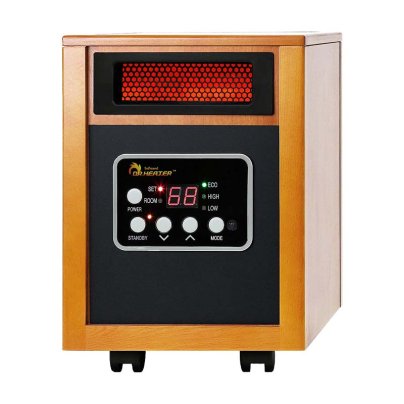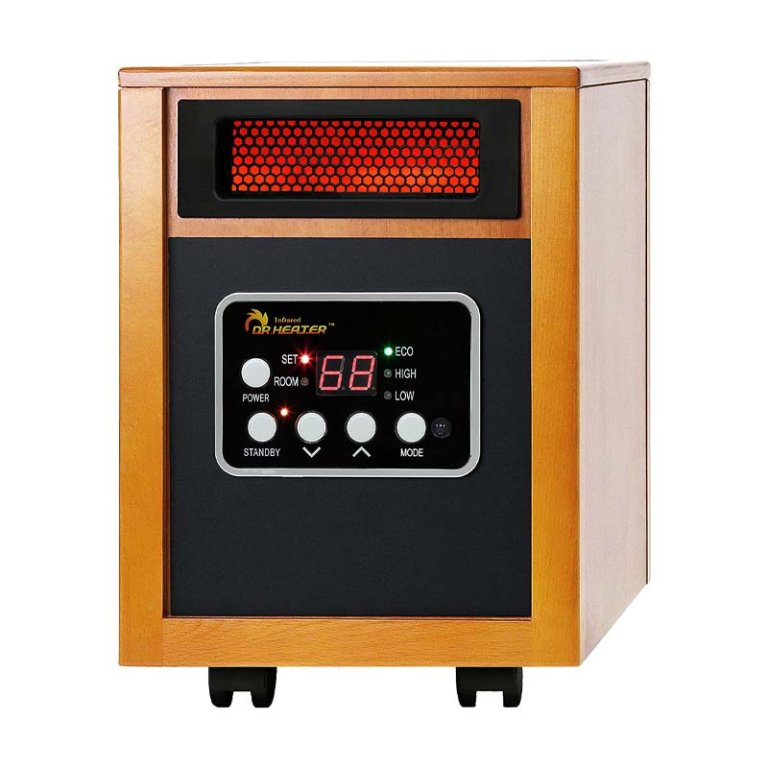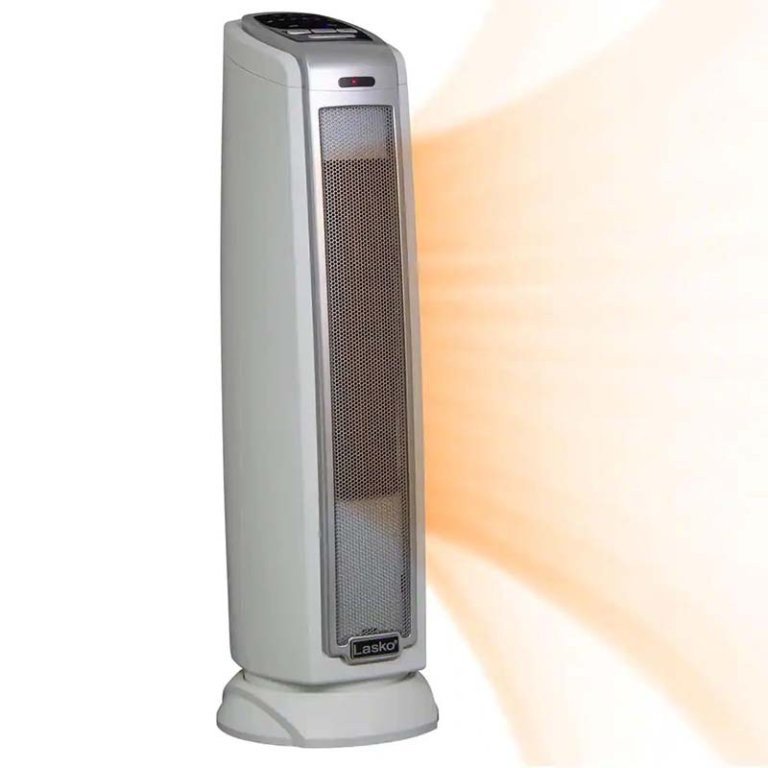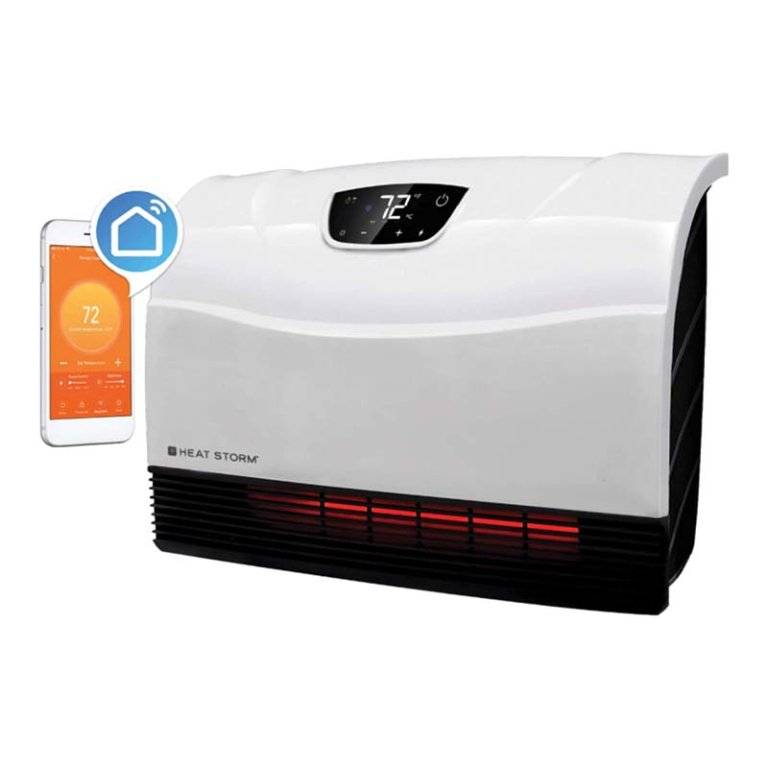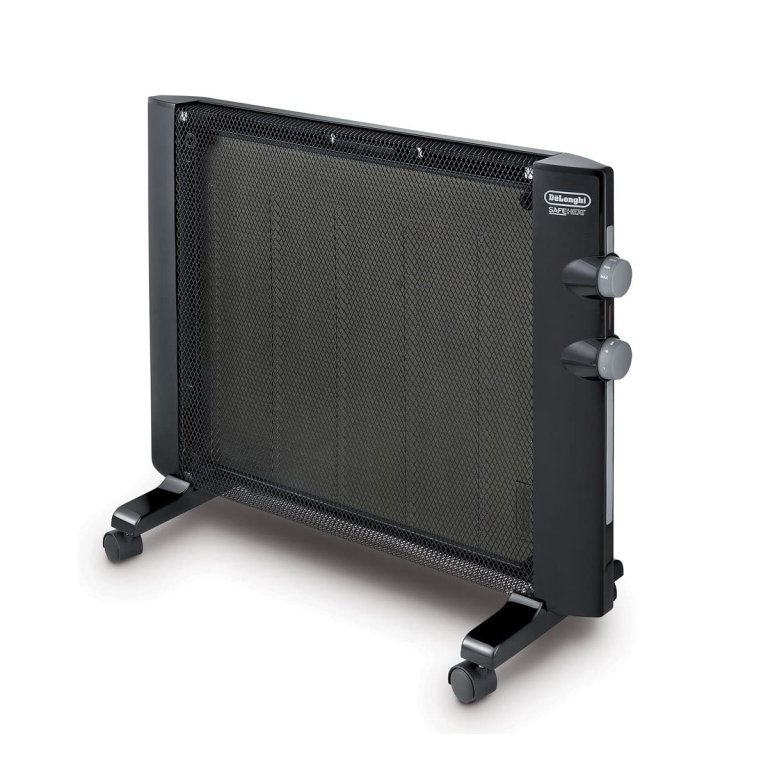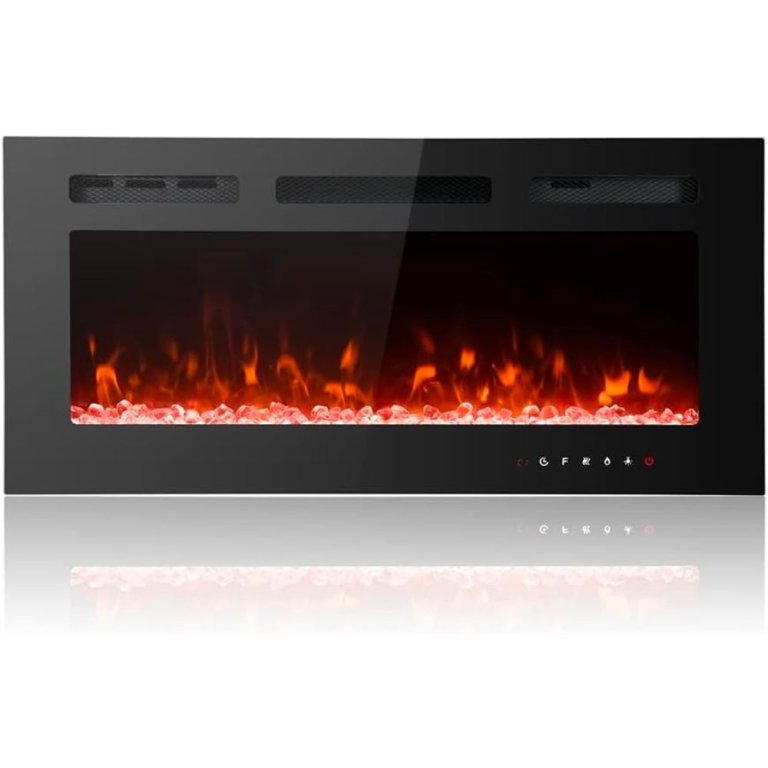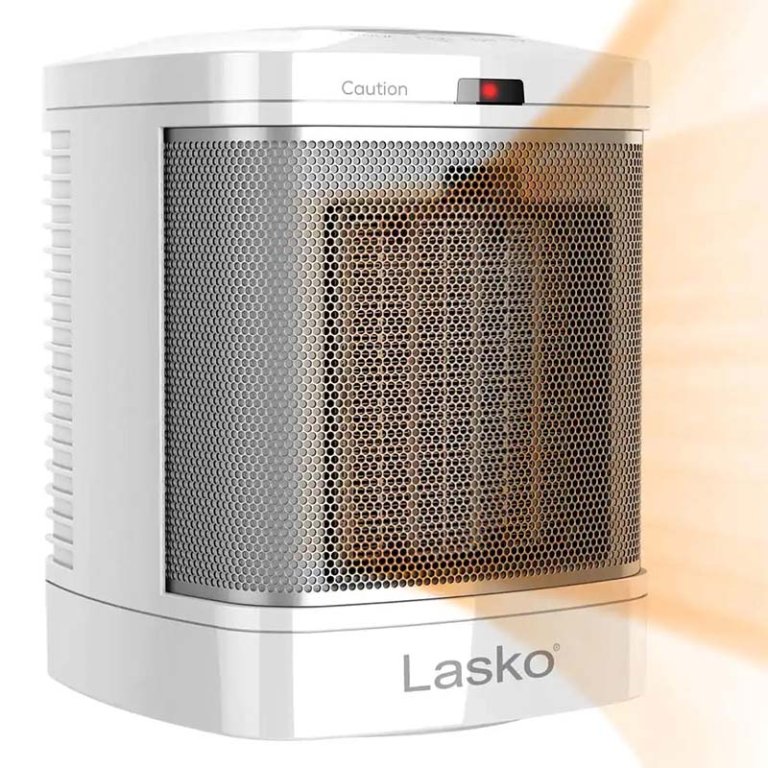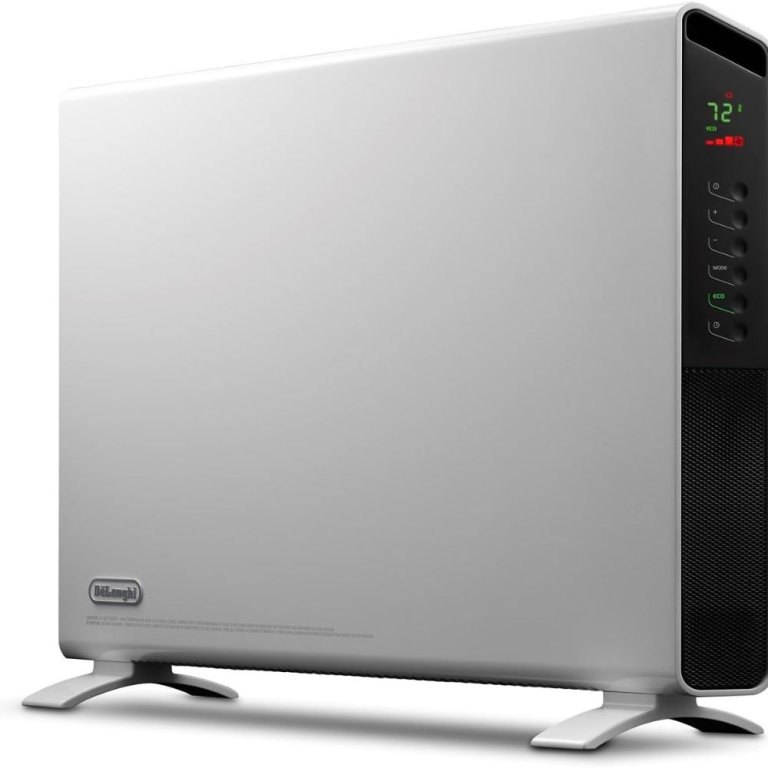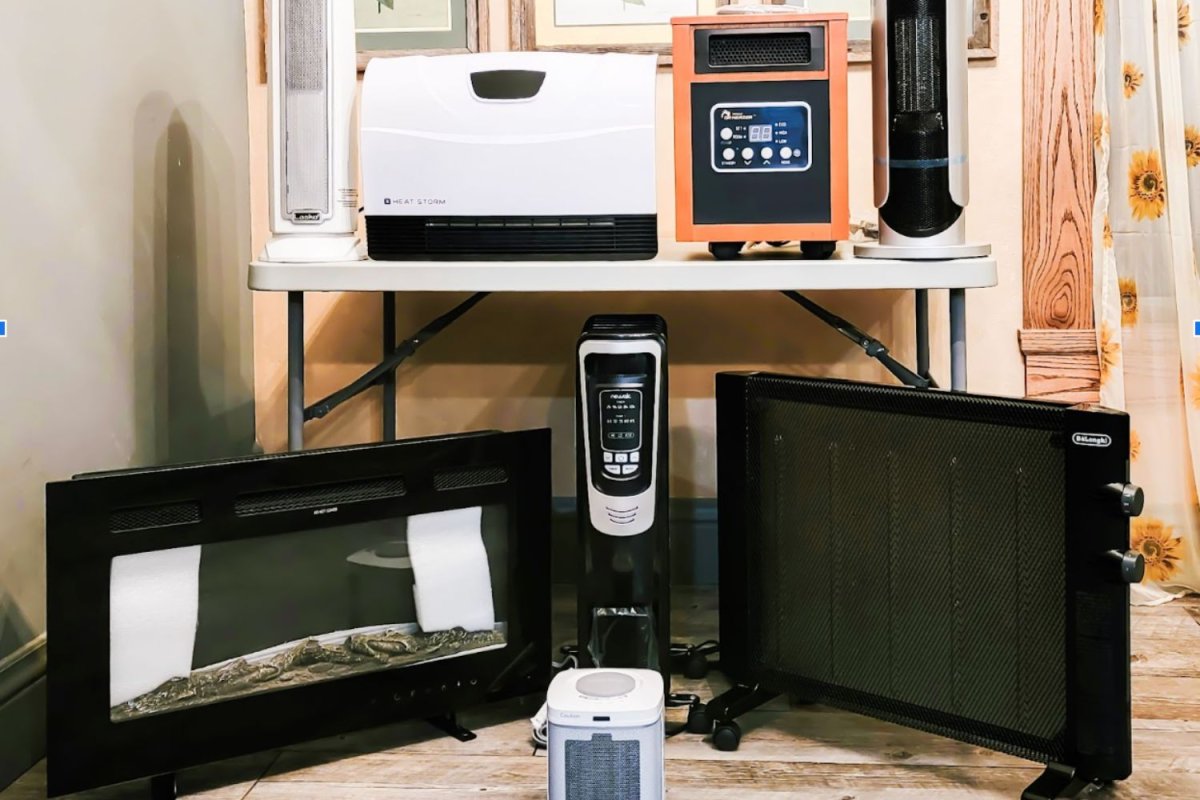
We may earn revenue from the products available on this page and participate in affiliate programs. Learn More ›
When the weather turns chilly, the best energy-efficient space heaters offer a convenient and cost-effective way to improve home and office comfort. With so many models out there, it’s not always easy to tell which are worth buying. We tested 13 energy efficient space heaters to see which ones really came out on top. Our team of expert product reviewers looked at top brands and models to see how much heat they produced and whether they offered energy-saving features, such as built-in thermostats and timers. We ranked the Dr. Infrared Heater DR-966 portable space heater as our top pick overall, which we loved for its appearance, efficiency and range of heat levels.
For many, a space heater is a must-have home appliance, especially in the winter, providing warmth in living spaces or temporary heat in a garage or a workshop. Keep reading to find out how the following products earned a spot in our top picks list for the best energy-efficient space heater and discover the pros and cons of each one.
- BEST OVERALL: Dr. Infrared Heater DR-968 Portable Space Heater
↓ Jump to Review - BEST BANG FOR THE BUCK: Lasko Electric Oscillating Ceramic Tower Space Heater
↓ Jump to Review - MOST VERSATILE: Heat Storm HS-1500-PHX Infrared Space Heater
↓ Jump to Review - BEST MICATHERMIC: De’Longhi HMP1500-6A Mica Panel Heater
↓ Jump to Review - BEST AMBIENCE: Maxhonor Electric Fireplace Heater With Remote
↓ Jump to Review - BEST FOR BATHROOMS: Lasko Ceramic Bathroom Space Heater With Safety Plug
↓ Jump to Review - BEST FOR BASEMENTS: De’Longhi SlimStyle Digital Convection Panel Heater
↓ Jump to Review
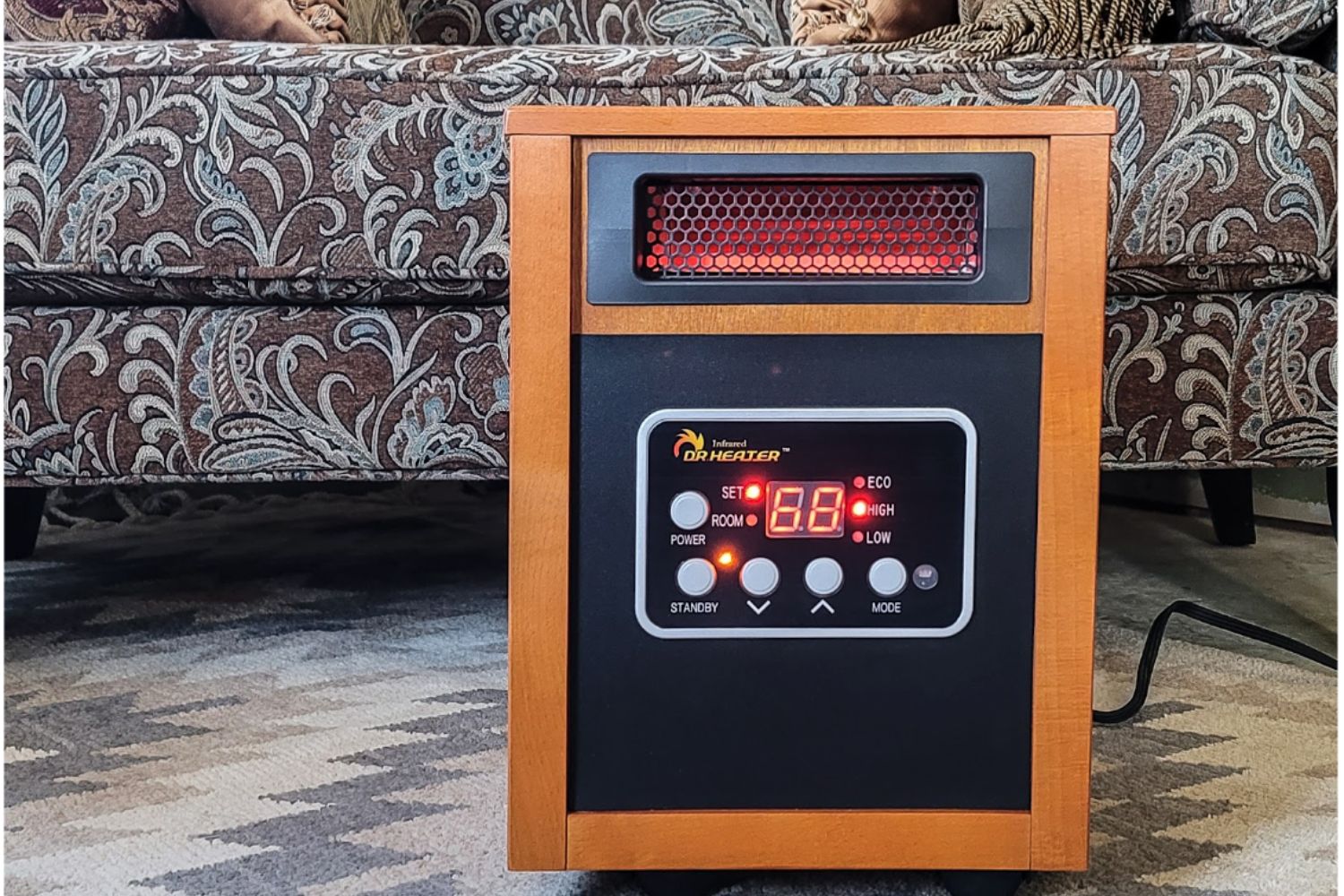
Our Top Picks
In one of the coziest tests we’ve ever conducted, the following lineup of electric space heaters came out on top. Each offers a variety of benefits, ranging from quick heating, a cool-touch exterior, remote control, and/or the safe heating of moisture-prone rooms such as bathrooms. Find out what we liked (and didn’t like) about each model before choosing one for your home.
Best Overall
Dr. Infrared Heater DR-968 Portable Space Heater
See ItWhat We Like
- Features 3 heating modes to suit individual needs
- Digital numbers are large and easy to see
- Warms up room quickly and maintains temperature on auto
- Attractive and easy to move around
What We Don’t Like
- Standby mode feels unnecessary
Product Specs
- Type: Infrared
- Watts: 1,500
- Power source: Corded electric
Right out of the box, we were sold on the attractiveness of the Dr. Infrared Heater. It’s encased in solid wood that matches any decor. We tested the 1,500-watt Dr. Infrared in a 156-square-foot room.
This heater runs quiet—it emitted just a slight hum during operation. We set the thermostat 5 degrees Fahrenheit higher than the existing room temperature, turned the space heater on high, and closed the door to see how long it would take to warm the room. Within 15 minutes, we could feel a temperature difference; at 33 minutes, the room’s temperature had increased by 10 degrees.
We tried out additional features such as the timer function, heat output on low and eco modes, and standby mode. Standby mode means a light remains on to let you know the heater is plugged in, which feels unnecessary. We liked the timer function, which let us select a running time up to 12 hours, which worked well. We were able to operate the heater both from the unit itself and via a remote. Last but not least, we tipped the heater over, and it immediately shut off—a space heater safety feature to prevent accidental fires.
What our tester said: “My favorite function of the Dr. Infrared was the thermostat control. I could just select the desired temperature and the heater would go on and off as needed to keep the room a consistent temperature.” —Tom Scalisi, Product Reviews tester and writer
Get the Dr. Infrared energy-efficient space heater at Amazon, Lowe’s, or The Home Depot.
Best Bang for the Buck
Lasko Electric Oscillating Ceramic Tower Space Heater
See ItWhat We Like
- Remote control for easy temperature adjustment
- Powerful but quiet
- Oscillating capability heats room more evenly
- Turns off immediately when tipped over
- Cool-to-touch ceramic exterior
- Built-in handle and lightweight
What We Don’t Like
- No tip over protection
Product Specs
- Type: Ceramic
- Watts: 1,500
- Power source: Corded electric
There’s no need to spend a lot on a space heater. The 1,500-watt Lasko ocisslating digital ceramic space heater combines oscillating action with a blower for the effective heating of moderately sized rooms. As with many of today’s electric heaters of this kind, we found the exterior stayed cool to the touch while the heater was running. Plus, there’s tip-over protection to reduce the risk of fires.
The heater is easy to adjust via the control panel on the top of the unit or with the included remote. It features 1,500 watts of heat-producing power on high, so we tested it in our 156-square-foot room and it performed well, heating the room to the desired temperature in just over 20 minutes. The oscillating feature helped distribute heat evently and made the room cozy. The unit also features a timer with one-hour increments, up to 8 hours.
Get the Lasko Tower energy-efficient space heater at Amazon.
Most Versatile
Heat Storm HS-1500-PHX Infrared Space Heater
See ItWhat We Like
- Wi-Fi capable; syncs with a home network
- Operate via an app on smart device
- Use on floor, table or wall-mounted
- Comes with a remote control
What We Don’t Like
- Wall-mounting holes don’t match with wall studs
Product Specs
- Type: Infrared
- Watts: 1,500
- Power source: Corded, electric
This Heat Storm infrared space heater has 1,500 watts of heating power, so we tested it in a 156-square-foot room. Since it boasts smart capabilities, we downloaded the Smart Life app and synced the heater with our Wi-Fi. We could monitor the room’s existing temperature, turn the space heater on, set a programming schedule, and adjust room temperature all via the app.
It took 18 minutes for the Heat Storm to increase the temperature in the room by 5 degrees Fahrenheit. It was quiet, emitting a soft hum from its fan. This model can be placed on a table or floor with a pair of easy-to-attach plastic feet. The feet kept the heater level and stable. The unit also has tip-over protection for safety.
We weren’t big fans of the wall-mounting setup. The mounting holes on the backside are 13.75 inches apart, too short a distance to mount to studs that are typically 16 inches apart. This means only one screw can go into a stud, while the other must be inserted in drywall with an anchor bolt. The Heat Storm weighs 9 pounds, so it’s probably okay to mount in drywall, but we would have preferred to mount it to two studs for extra stability.
The Heat Storm comes with a remote and includes a timer that is accessible from the app or remote. We appreciated the versatility of the unit and being able to control it from a touchscreen on the unit or via the app.
Get the Heat Storm energy-efficient space heater at Amazon, Lowe’s, or The Home Depot.
Best Micathermic
De’Longhi HMP1500-6A Mica Panel Heater
See ItWhat We Like
- Adjust heat and fan from 2 side dials
- Shuts off immediately when tipped over
- Attachable caster wheels for easy rolling
- Option to mount the unit to a wall
What We Don’t Like
- Front panel becomes hot to the touch
Product Specs
- Type: Micathermic
- Watts: 1,500
- Power source: Corded, electric
Micathermic heaters use a combination of convection and infrared heating to bring warmth to the room. During testing, this 1,500-watt De’Longhi model, set on high, raised the temperature in our 156-square-foot room by 5 full degrees Fahrenheit in 18 minutes. It has a narrow panel design that produces radiant heat from the front of the heater while the sides and back remain cool. This compact, slim design is also space saving, and the unit was pretty quiet while running.
The included caster wheels were easy to attach via hand-twisted knobs on the bottom (no tools necessary). This heater can also be mounted on a wall but will require drywall anchors, which are not included. By simply twisting the control dials on the side of the heater, we could adjust the heat level and fan speed. It turned off immediately when we tipped it over. Our only concern is that the front panel does become hot to the touch, so we would not recommend it for families with small children unless it’s mounted out of reach on a wall.
Get the De’Longhi energy-efficient space heater at Amazon (white model only), De’Longhi, or Preferred Living.
Best Ambience
Maxhonor Electric Fireplace Heater With Remote
See ItWhat We Like
- Fireplace-type produces both warming heat plus attractive flames
- Unit remain cool while heater is running
- Touch screen and remote control options
What We Don’t Like
- Took longer to heat room
- May require additional electrical outlet if recessed
Product Specs
- Type: Ceramic
- Watts: 1,500
- Power source: Corded, electric
Most space heaters don’t do much for aesthetics, but the Maxhonor electric fireplace lights things up with delightful faux flames, producing heat and so ambiance. While it’s a 1,500-watt heater, it took almost 30 minutes on high to raise the temperature in our 156-square-foot test room by 5 full degrees Fahrenheit. We assumed some of the wattage was being used to create the dancing flames, which are the focal point of this unit. We tested a 30-inch model, but wider models—up to 60 inches—are available.
The heater is controlled via a touch panel along the bottom edge or the included remote control. There are several flame colors, including blues and greens.The glass screen remains cool to the touch, and heat exits through a panel near the top, making this space heater suitable for a home with small children—as long as the upper heat vent is above their reach. It also features a sleep timer.
This fireplace heater is designed to be surface mounted on a wall, set on the floor, or recessed in the wall itself. However, if users purchase this heater to recess in a wall, be aware that it must still be plugged into an outlet. This means the user will need to have an outlet installed in the stud space (requiring an electrician) or drill a hole in the wall for the 6-foot cord to exit and plug in. Extension cords should not be used with space heaters due to increased fire risk.
Get the Maxhonor energy-efficient space heater at Amazon,Walmart (50-inch model), or Fire In Style.
Best for Bathrooms
Lasko Ceramic Bathroom Space Heater With Safety Plug
See ItWhat We Like
- Safety plug trips to prevent shocks
- Large push button on the top of the heater
- Compact size
- Efficient with 1,500 watts of heating power
What We Don’t Like
- Lack of tip-over protection is a safety concern
- No remote control
Product Specs
- Type: Ceramic
- Watts: 1,500
- Power source: Corded, electric
Water and electricity don’t mix, so most space heaters are a poor choice for adding warmth to bathrooms. The Lasko ceramic space heater is a safer choice, thanks to its appliance leakage current interrupter (ALCI) safety plug. The plug contains an internal breaker that switches the electrical current off if it detects an imbalance in the electrical current, which keeps the user from being shocked.
The Lasko has 1,500 watts of power, so we tested it in our 156-square-foot room. It took 20 minutes for the little heater to increase the room temperature by 5 degrees Fahrenheit. The large button on the top requires only a gentle push to turn the heater on. Push the button again to scroll through high, low, fan only, and a 1-hour timer.
We ran an additional test in the garage (we didn’t want to risk damaging an indoor outlet if the safety plug failed). We turned the heater on and, while running, sprayed it with water. Once it was saturated with water, the unit made a sizzling noise and the ALCI plug tripped, shutting off the current. We were impressed.
After the Lasko dried out (we gave it 3 days), we plugged it back in and reset the plug—and it worked just as well. The safety plug makes it well suited for bathrooms, kitchens, laundry rooms, or other areas where moisture can be an issue. It doesn’t have automatic tip-over protection so It won’t shut off if accidentally knocked over.
Get the Lasko bathroom energy-efficient space heater at The Home Depot or Lasko.
Best for Basements
De’Longhi SlimStyle Digital Convection Panel Heater
See ItWhat We Like
- Antifreeze mode when temps drop below 45 degrees Fahrenheit
- Mounts to the floor or stands on 2 legs
- Runs nearly silently in most modes
What We Don’t Like
- Doesn’t come with a remote
Product Specs
- Type: Convection
- Watts: 1,500
- Power source: Corded, electric
Since basements are typically full of plumbing systems, it would make sense that residents want to protect their basements from freezing temperatures. And while it’s a completely capable space heater in every regard, the De’Longhi SlimStyle digital convection panel heater is ideal for protecting these spaces. This model features several modes, one of which is designed to kick on when the space around it drops to 45 degrees Fahrenheit. This antifreeze mode allows it to stay dormant and use very little energy until the temperatures plummet—something most other space heaters can’t do since their lowest setting is usually around 60 degrees Fahrenheit.
The De’Longhi runs quietly through three out of its four standard run modes. The fourth mode activates two fans, which blow heat throughout the space and encourage the convection process. The unit can be floor- or wall-mounted (it comes with the hardware for both), and it features tip-over and overheat protection for safety. Users can set the De’Longhi to eco mode or set timers to prevent unnecessary energy consumption.
It’s important to note that when tested the antifreeze mode turned the heater on at 45 degrees Fahrenheit, not 41 degrees Fahrenheit like the manufacturer’s site suggests. We liked the digital display, which was easy to use to set the heater, but we don’t like that it doesn’t come with a remote.
What our tester said: “Most space heaters can’t be set to temperatures lower than 60 degrees Fahrenheit, so using them to keep pipes from freezing is an energy pit. I liked that the De’Longhi could handle this job without drawing much power at all, keeping the utility bill as modest as possible.” —-Tom Scalisi, Product Reviews tester and writer
Get the De’Longhi energy-efficient space heater at Amazon, Wayfair, or QVC.
ALSO TESTED:
The Dr. Infrared’s DR-908 HeatStyle 2-Way Heater didn’t make the cut. It wasn’t all bad, as it was quiet and relatively easy to use. However, it’s far from the cheapest option on the list and ours came with a misaligned shroud and poor fit and finish. It also doesn’t come with a template for attaching to a wall, so we expect inexperienced DIYers to struggle installing it. All these things considered, it simply didn’t pass our tests.
Jump to Our Top Picks
How We Tested the Best Energy-Efficient Space Heaters
We extensively researched more than 35 different space heaters before selecting the models for our hands-on testing. We looked for space heaters with thermostat controls and features like timers, programming, and smart capabilities that could help home users regulate electrical use to save money.
We followed the manufacturer’s instructions while testing the heaters, noting the maximum watts of each heater and using that to select the room size for testing. We also noted how long it took for the temperature to increase by 5 degrees Fahrenheit in the room.
In addition to producing heat, we also rated each model on ease of operation, noise level, thermostat accuracy (as compared to an indoor thermometer), portability, and safety features. If the heater featured smart capabilities, we synced it with our Wi-Fi or smart device and noted how well the app worked for controlling or monitoring the heater.
However, keep in mind that a space heater’s efficiency can vary depending on environment, so your results may differ from ours. Things like high ceilings, large windows, inadequate wall insulation, and outdoor temperature affect how quickly a space heater will warm a room.
| Testing Stats | |
| Products tested | 13 |
| Hours/Weeks/Time spent testing | 2 weeks |
| Tests performed | 7 |
| Price range | $45-$189 |
What to Consider When Choosing an Energy-Efficient Space Heater
While kerosene and propane space heaters do exist, challenges with fumes and dangerous fuels mean the majority of space heaters used in the home are electric. Even narrowing the choices to electric-powered heaters still leaves a vast range of space heaters to choose from. It’s essential to look at several key elements.
Type
Before looking at the different types of space heaters, it’s worth thinking about how heat is produced. While there are radiant heaters and micathermic heaters, most space heaters use convection (a fan blowing over a heating element) to heat the air.
- Oil-filled radiators are perhaps the oldest kind of electric space heater. Generally designed for medium to large rooms, they are quite bulky and usually have wheels to aid mobility. They provide some radiant heat while mainly heating the air.
- Ceramic heaters are probably the most popular type, and there is an enormous variety. Usually either box- or tower-shaped models, they are light enough to be moved around easily and powerful enough for larger-than-average-size rooms. Forced-air (sometimes called bladeless) versions of ceramic heaters can help spread warmth around a room more quickly and evenly.
- Infrared space heaters work much faster than convection heaters and don’t waste energy heating an unattended room. Considered a type of radiant heater, they work in a direct path, or “line of sight,” so they’re only at maximum efficiency when there’s nothing between people and the heater.
- Micathermic space heaters, available as panel heaters and similar in design to oil-filled models, contain a stone (mica) heating element that produces electromagnetic waves when heated. In effect, they produce both convection and radiant heat. While highly efficient, the design choice is currently somewhat limited. Many resemble a large metal panel.
Room Size and Heating Capacity
Space heaters come in various sizes and power options, so there’s something for most every situation. Heat output is measured in watts, and general guidance is that 10 watts per square foot is needed to maintain a comfortable warmth. Therefore, a 100-square-foot room would require a 1,000-watt space heater.
How many watts does a space heater use? Space heater wattage can vary quite a bit. Desktop models are around 200 to 400 watts, which can be very good for direct heat for modest personal spaces like a home office or basement. The most common heat output in space heaters is 1,500 watts, sufficient for a 15-foot-long by 10-foot-wide room. Heaters of 2,000 watts and upward are available, but large electric models may need to be hardwired.
Energy Efficiency
When looking for a space heater that is energy efficient it’s important to remember that space heaters
aren’t usually a replacement for central heating, but they can offer excellent efficiency and big savings if they are only needed to heat a room or two. This can often be the case as the seasons change and some parts of the house are cooler than others.
Additional energy efficiency comes by way of features on the space heaters themselves. A space heater with a thermostat and adjustable heat settings allows increased control, so energy isn’t wasted. Sleep or auto-off timers can be set to turn the heater off after a preset period, though most do not provide an automatic “on” setting.
Smartphone apps allow access from anywhere. Control via Wi-Fi offers an increasingly large array of features, like remotely turning on the device so rooms can be warm when people return from school or work. There’s also the possibility of voice activation via smart-home systems like Alexa and Google Assistant. Allowing the user greater control provides the opportunity to maximize energy efficiency.
Safety Features
Some space heaters become warm to the touch, so care needs to be taken if there are children and animals around. Fabrics and soft furnishings also need to be spaced away from the heater. It may be worth looking for cool-touch housings as an additional way to prevent accidents.
Overheat protection will turn off a space heater if it heats up internally to protect it from damage. Most space heaters also have tilt- or tip-over protection so the unit will turn itself off if it falls or is knocked over.
Propane and kerosene space heaters give off toxic carbon monoxide gas, which can collect in unventilated rooms and may present a serious health hazard. Some models for indoor use have a sensor that checks oxygen levels and turns the heater off if the oxygen decreases to hazardous levels.
Noise Level
Few of the best energy-efficient electric space heaters could be described as particularly loud, though the noise levels vary. The culprit is almost always the fan. However, oil-filled and micathermic models often have no fan, nor do some infrared models. While they might make a little noise when first heating up, they are quiet during regular operation.
Ceramic space heaters generally have some kind of blower, and forced-air models make a feature of it. This can cause them to be noisier on high settings. Few manufacturers provide decibel ratings. While most models are not intrusive, the heaters with louder powerful blowers may not be best for bedroom use.
Tips for Using an Energy-Efficient Space Heater
Regardless of the type of space heater chosen, optimal energy efficiency will always come from ensuring it’s the right size for the area. If it is moved from room to room, then the largest room size should be used, or it will struggle to provide sufficient warmth.
On the other hand, there is no point in oversizing. Achieving the most heat value for the cost to run it will come from being as accurate as possible. If there are two very different-size rooms, consider buying two heaters.
- Read the manual carefully to thoroughly understand all the features available and how to maximize the efficiency of the space heater.
- Space heaters are best used in individual rooms, so keep doors closed as much as possible to prevent heat from escaping.
- A low wattage space heater doesn’t necessarily mean it is more energy efficient
- Even if the unit’s exterior is relatively cool, keep a minimum safe space of 3 feet between the space heater and any fabric or furniture. Check the owner’s manual to see if the manufacturer recommends a larger gap.
- If it is intended for bedroom use, check whether it is safe to leave the heater on during the night and if it has an auto shutoff.
- Never run power cords under carpets where damage can occur that might go unnoticed.
- Opt for space heaters with overheat protection if they will be running at night.
FAQs
The sections above tackled the technical aspects of energy-efficient space heaters, and our hands-on testing revealed some of the best space heaters available. However, this is a complex subject, and several additional questions crop up frequently. Answers to some of these common questions are below.
Unfortunately, there are no recognized standards. An Underwriters Laboratories or Electrical Testing Laboratories listing is sometimes quoted, but this ensures the space heater meets current safety standards rather than certifying efficiency. The U.S. Department of Energy website says it’s essential to choose the right-size heater for the room (don’t oversize) and recommends space heaters with a thermostat, so the room isn’t overheated.
It’s difficult to answer what the single most energy efficient space heater is because numerous factors have an impact. Strictly speaking, infrared is probably the most efficient, but not necessarily the right choice. It’s important to consider all the factors above to find the best space heater for energy efficiency.
Utility company charges, room size, and insulation level all impact cost, but 1,500-watt energy-efficient space heaters typically cost around $7 to $9 to operate for 24 hours.
Central heating is more efficient if the desire is to keep the whole house at a constant temperature for weeks at a time. Space heaters are more efficient in three ways:
– Heating personal spaces
– Heating rooms were added after the original central heating was installed
– Boosting the heat in one or more areas when you don’t want to turn the heat up in the entire house
Electricity consumption is calculated in kilowatts per hour. A kilowatt is 1,000 watts. In general, consumption relates directly to the device’s wattage, so you’ll save money if you can turn it down. A low wattage space heater that uses the least electricity comes with lower heat settings—200- to 400-watt personal heaters—but they provide insufficient warmth for typical family rooms. So sometimes the most economical space heater won’t be sufficient.
There is no specific number of years that a space heater may last. If used safely and following manufacturer instructions, a space heater may last years. The amount of use will also factor in: a space heater that is used occasionally will last longer than one that is the primary heat source for a room.
While some space heaters have extended periods of time they will run before automatically shutting down, it is generally advised that no space heater should be left on overnight. A space heater that is energy efficient will heat a room and automatically shut off, coming on only to maintain that pre-set room temperature.
Space heaters should be placed out of busy areas in the home to make sure they are not easily tipped over. They should be placed on level, hard surfaces that are non flammable. They should be at least three feet from the wall and any bedding or flammable materials, such as sofas, curtains, or rugs. They should never be plugged in using an extension cord, as this increases fire risk.
Meet the Testers
Tom Scalisi is a freelance writer specializing in the home design, construction, tools, and automotive industries. As a lover of all things tools, construction, and DIY, he’s always looking for new tools and techniques.
Glenda Taylor is a product tester and writer specializing in the construction, remodeling, and real estate industries. She tests a wide range of tools and home improvement products.
Additional research provided by Bob Beacham.
